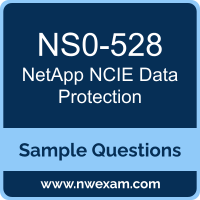01. When SnapMirror SVM replication is first initialized, it places data volumes on data aggregates on the destination cluster. What is the first criteria used to select which volumes will be placed on a data aggregate?
a) Data aggregates with the same RAID type and number of disks as the Source aggregate
b) Data aggregates with the same disk type
c) Data aggregates with FabricPool enabled are preferred
d) Data aggregates elected based on the available free space and the number of volumes already hosted on the aggregate
02. Your customer needs to store WORM data using NetApp ONTAP software. Which three protocols are supported?
(Choose three.)
a) FC
b) iSCSI
c) NFS
d) ONTAP S3
e) CIFS
03. When creating SnapMirror Unified replication relationships, what would an administrator use to determine that their Source and Destination ONTAP versions are compatible?
a) Active IQ Upgrade Advisor
b) NetApp Interoperability - Matrix Tool (IMT)
c) Cloud Manager Release Notes
d) Compatible ONTAP versions for SnapMirror relationships
04. An administrator has been tiering data to a bucket on the local cluster and will now like to SnapMirror to a bucket on the remote cluster, configuring via the CLI. Which two service policy configurations are required on the S3 LIF?
(Choose two.)
a) intercluster-core
b) data-core
c) data-s3-server
d) cluster-core
05. You have been tasked to configure and enable NetApp Autonomous Ransomware Protection (ARP) on your ONTAP 9.14.1 cluster. How would you set the optimal learning period?
a) ONTAP automatically sets learning period
b) ONTAP does not require a learning period
c) manually set learning period to 15 days
d) manually set learning period to 30 days
06. Which NetApp ONTAP solution uses the SyncMirror feature?
a) SnapMirror Synchronous
b) MetroCluster
c) SnapMirror active sync
d) SnapMirror Asynchronous
07. Your customer wants to maintain hourly and daily Snapshot copies on their primary system and a longer retention of daily Snapshot copies on a secondary system. Which two settings must you set to achieve this result?
(Choose two.)
a) Set up a protection policy with the correct labels and retention on the secondary system.
b) Set up a Snapshot policy with the correct labels and retention on the primary system.
c) Set up a protection policy with the correct labels and retention on the primary system.
d) Set up a Snapshot policy with the correct labels and retention on the secondary system.
08. What is 3-2-1 data protection strategy?
a) three copies of the data on two different media types, with one of the backup copies stored off-site.
b) three copies of the data on two different sites, with one of the backup copies stored on-site.
c) three copies of the data on two different media types, with one of the backup copies stored on-site.
d) three copies of the data on two different sites, with one of the backup copies stored off-site.
09. You need to establish a NetApp SnapMirror data protection relationship between an existing NetApp ASA ONTAP Cluster and a new NetApp AFF C-Series Cluster. Which two configurations are needed for replication?
(Choose two.)
a) Disable storage efficiencies when replicating between these two platform models.
b) The source and destination systems must be using the same ONTAP version.
c) The source and destination systems must be cluster peers.
d) The source and destination SVMs must be peers.
10. Which NetApp ONTAP technology is used to restore a file using Windows previous versions?
a) MetroCluster
b) Snapshot
c) SnapMirror
d) FlexClone
 Before you write the NetApp NCIE Data Protection (NS0-528) certification exam, you may have certain doubts in your mind regarding the pattern of the test, the types of questions asked in it, the difficulty level of the questions and time required to complete the questions. These NetApp Certified Implementation Engineer - Data Protection Specialist (NCIE-DP) sample questions and demo exam help you in removing these doubts and prepare you to take the test.
Before you write the NetApp NCIE Data Protection (NS0-528) certification exam, you may have certain doubts in your mind regarding the pattern of the test, the types of questions asked in it, the difficulty level of the questions and time required to complete the questions. These NetApp Certified Implementation Engineer - Data Protection Specialist (NCIE-DP) sample questions and demo exam help you in removing these doubts and prepare you to take the test.